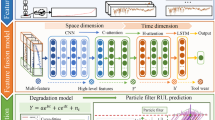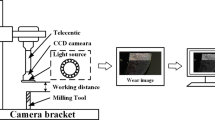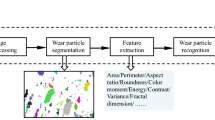Abstract
With the proliferation of sensing technology and artificial intelligence, tool wear prediction under multi-sensor signals has received widespread attention. However, there is still significant potential to explore how to effectively and adaptively extract and fuse features implied in multi-signal and leverage them for decision-making. In this work, we propose a two-stage tool wear prediction framework based on dual fusion of multi-feature and decision-making. Firstly, relying on the second-order derivative of the tool wear curves, they can be roughly categorized into three stages: slight, stable, and severe wear. Next, a scale-spatial attention mechanism-based multi-scale convolutional model is designed for each wear phase, which organically combines the extraction, fusion, and utilization of spatial and temporal features, enabling local decision-making. Notably, due to the scale-spatial attention mechanism, the model automatically aggregates and highlights important information related to the current wear phase. Finally, a dynamic weight-based decision-making fusion strategy is developed to learn a comprehensive representation of tool wear across three models. This strategy adaptively determines the probability of belonging to each wear stage from unsegmented input data. We evaluate the effectiveness of our proposed method using a real milling dataset through ablation and comparison experiments, and it is found to be superior to other advanced approaches, with an average R2 of predicted results as high as 0.9968.














Similar content being viewed by others
Change history
20 September 2023
Springer Nature’s version of this paper was updated to present correct format of equation 8.
References
Kurada S, Bradley C (1997) A review of machine vision sensors for tool condition monitoring. Comp Ind 34(1):55–72. https://doi.org/10.1016/S0166-3615(96)00075-9
Liu H, Liu Z, Jia W, Lin X, Zhang S (2020) A novel transformer-based neural network model for tool wear estimation. Meas Sci and Technol 31(6):065106. https://doi.org/10.1088/1361-6501/ab7282
Liu C, Zheng P, Xu X (2021) Digitalisation and servitisation of machine tools in the era of Industry 4.0: a review. Int J Prod Res 1-33. https://doi.org/10.1080/00207543.2021.1969462
Wu D, Liu S, Zhang L, Terpenny J, Gao RX, Kurfess T, Guzzo JA (2017) A fog computing-based framework for process monitoring and prognosis in cyber-manufacturing. J Manuf Syst 43:25–34. https://doi.org/10.1016/j.jmsy.2017.02.011
Wang J, Xie J, Zhao R, Zhang L, Duan L (2017) Multisensory fusion based virtual tool wear sensing for ubiquitous manufacturing. Robot Comput Integr Manuf 45:47–58. https://doi.org/10.1016/j.rcim.2016.05.010
Nouri M, Fussell BK, Ziniti BL, Linder E (2015) Real-time tool wear monitoring in milling using a cutting condition independent method. Int J Mach Tool Manu 89:1–13. https://doi.org/10.1016/j.ijmachtools.2014.10.011
Mohanraj T, Shankar S, Rajasekar R, Sakthivel NR, Pramanik A (2020) Tool condition monitoring techniques in milling process—a review. J Mater Res Technol 9(1):1032–1042. https://doi.org/10.1016/j.jmrt.2019.10.031
Huang PB, Ma CC, Kuo CH (2015) A PNN self-learning tool breakage detection system in end milling operations. Appl Soft Comput 37:114–124. https://doi.org/10.1016/j.asoc.2015.08.019
Lee JH, Lee SJ (1999) One-step-ahead prediction of flank wear using cutting force. Int J Mach Tools Manuf 39(11):1747–1760. https://doi.org/10.1016/S0890-6955(99)00029-2
Zhou C, Yang B, Guo K, Liu J, Sun J, Song G, Zhu S, Sun C, Jiang Z (2020) Vibration singularity analysis for milling tool condition monitoring. Int J Mech Sci 166:105254. https://doi.org/10.1016/j.ijmecsci.2019.105254
Shi C, Panoutsos G, Luo B, Liu H, Li B, Lin X (2018) Using multiple-feature-spaces-based deep learning for tool condition monitoring in ultraprecision manufacturing. IEEE Trans Ind Electron 66(5):3794–3803. https://doi.org/10.1109/TIE.2018.2856193
Salimi A, Zadshakoyan M, Özdemir A, Seidi E (2013) Designing an intelligent system to predict drill wear by using of motor current and fuzzy logic method. Acta Sci Technol 35(4):669–676. https://doi.org/10.4025/actascitechnol.v35i4.15647
Wilkinson P, Reuben RL, Jones JDC, Barton JS, Hand DP, Carolan TA, Kidd SR (1999) Tool wear prediction from acoustic emission and surface characteristics via an artificial neural network. Mech Syst Signal Process 13(6):955–966. https://doi.org/10.1006/mssp.1999.1231
Maia LHA, Abrao AM, Vasconcelos WL, Sales WF, Machado AR (2015) A new approach for detection of wear mechanisms and determination of tool life in turning using acoustic emission. Tribol Int 92:519–532. https://doi.org/10.1016/j.triboint.2015.07.024
Benkedjouh T, Medjaher K, Zerhouni N, Rechak S (2015) Health assessment and life prediction of cutting tools based on support vector regression. J Intell Manuf 26:213–223. https://doi.org/10.1007/s10845-013-0774-6
Rowes ST (2000) Nonlinear dimensionality reduction by locally linear embedding. Science 290:232. https://doi.org/10.1126/science.290.5500.2323
Tenenbaum JB, Silva VD, Langford JC (2000) A global geometric framework for nonlinear dimensionality reduction. Science 290(5500):2319–2323. https://doi.org/10.1126/science.290.5500.2319
Shi D, Gindy NN (2007) Tool wear predictive model based on least squares support vector machines. Mech Syst Signal Process 21(4):1799–1814. https://doi.org/10.1016/j.ymssp.2006.07.016
Zhao R, Wang D, Yan R, Mao K, Shen F, Wang J (2017) Machine health monitoring using local feature-based gated recurrent unit networks. IEEE Trans Ind Electron 65(2):1539–1548. https://doi.org/10.1109/TIE.2017.2733438
Qiu G, Gu Y, Cai Q (2019) A deep convolutional neural networks model for intelligent fault diagnosis of a gearbox under different operational conditions. Measurement 145:94–107. https://doi.org/10.1016/j.measurement.2019.05.057
Chung J, Gulcehre C, Cho K, Bengio Y (2014) Empirical evaluation of gated recurrent neural networks on sequence modeling. arXiv preprint 1412.3555.https://doi.org/10.48550/arXiv.1412.3555
Hochreiter S, Schmidhuber J (1997) Long short-term memory. Neural Comput 9(8):1735–1780. https://doi.org/10.1162/neco.1997.9.8.1735
Cao XC, Chen BQ, Yao B, He WP (2019) Combining translation-invariant wavelet frames and convolutional neural network for intelligent tool wear state identification. Comput Ind 106:71–84. https://doi.org/10.1016/j.compind.2018.12.018
Liu X, Zhang B, Li X, Liu S, Yue C, Liang SY (2022) An approach for tool wear prediction using customized DenseNet and GRU integrated model based on multi-sensor feature fusion. J Intell Manuf 34(2):885–902. https://doi.org/10.1007/s10845-022-01954-9
Guo L, Yu Y, Gao H, Feng T, Liu Y (2021) Online remaining useful life prediction of milling cutters based on multisource data and feature learning. IEEE Trans Ind Inform 18(8):5199–5208. https://doi.org/10.1109/TII.2021.3118994
Galassi A, Lippi M, Torroni P (2020) Attention in natural language processing. IEEE Trans Neural Netw Learn Syst 32(10):4291–4308. https://doi.org/10.1109/TNNLS.2020.3019893
Chen Z, Wu M, Zhao R, Guretno F, Yan R, Li X (2020) Machine remaining useful life prediction via an attention-based deep learning approach. IEEE Trans Ind Electron 68(3):2521–2531. https://doi.org/10.1109/TIE.2020.2972443
Zhu Q, Xiong Q, Yang Z, Yu Y (2022) A novel feature-fusion-based end-to-end approach for remaining useful life prediction. J Intell Manuf 1-11. https://doi.org/10.1007/s10845-022-02015-x
Xu X, Wang J, Zhong B, Ming W, Chen M (2021) Deep learning-based tool wear prediction and its application for machining process using multi-scale feature fusion and channel attention mechanism. Measurement 177:109254. https://doi.org/10.1016/j.measurement.2021.109254
Zhang X, Lu X, Li W, Wang S (2021) Prediction of the remaining useful life of cutting tool using the Hurst exponent and CNN-LSTM. Int J Adv Manuf Technol 112:2277–2299. https://doi.org/10.1007/s00170-020-06447-8
Liu X, Liu S, Li X, Zhang B, Yue C, Liang SY (2021) Intelligent tool wear monitoring based on parallel residual and stacked bidirectional long short-term memory network. J Manuf Syst 60:608–619. https://doi.org/10.1016/j.jmsy.2021.06.006
Zhang KF, Yuan HQ, Nie P (2015) A method for tool condition monitoring based on sensor fusion. J Intell Manuf 26:1011–1026. https://doi.org/10.1007/s10845-015-1112-y
PHM society (2010) PHM society conference data challenge-PHM society https://www.phmsociety.org
Zeng Y, Liu R, Liu X (2021) A novel approach to tool condition monitoring based on multi-sensor data fusion imaging and an attention mechanism. Meas Sci Technol 32(5):055601. https://doi.org/10.1088/1361-6501/abea3f
ISO 8688–2 (1989) Tool life testing in milling - part 2: end milling. International Standards Institution Switzerland. https://www.iso.org/standard/16092.html
Rai A, Kim JM (2021) A novel pipeline leak detection approach independent of prior failure information. Measurement 167:108284. https://doi.org/10.1016/j.measurement.2020.108284
Javed K, Gouriveau R, Zerhouni N, Nectoux P (2014) Enabling health monitoring approach based on vibration data for accurate prognostics. IEEE Trans Ind Electron 62(1):647–656. https://doi.org/10.1109/TIE.2014.2327917
Wu D, Jennings C, Terpenny J, Gao RX, Kumara S (2017) A comparative study on machine learning algorithms for smart manufacturing: tool wear prediction using random forests. J Manuf Sci Eng 139(7). https://doi.org/10.1115/1.4036350
Chen Y, Jin Y, Jiri G (2018) Predicting tool wear with multi-sensor data using deep belief networks. Int J Adv Manuf Technol 99:1917–1926. https://doi.org/10.1007/s00170-018-2571-z
Liu H, Liu Z, Jia W, Zhang D, Wang Q, Tan J (2021) Tool wear estimation using a CNN-transformer model with semi-supervised learning. Meas Sci Technol 32(12):125010. https://doi.org/10.1088/1361-6501/ac22ee
Wu Z, Lu J, Li Y, Chen Y, Feng J, Ma J, Liao X (2022) Tool wear prediction under missing data through prioritization of sensor combinations. Int J Adv Manuf Technol 120(3-4):2715–2729. https://doi.org/10.1007/s00170-022-08916-8
Li X, Liu X, Yue C, Liang SY, Wang L (2022) Systematic review on tool breakage monitoring techniques in machining operations. Int J Mach Tools Manuf 103882. https://doi.org/10.1016/j.ijmachtools.2022.103882
Hu J, Shen L, Sun G (2018) Squeeze-and-excitation networks. IEEE Conf Comput Vis Pattern Recognit 7132-7141. https://doi.org/10.1109/CVPR.2018.00745
Liu H, Liu Z, Jia W, Lin X (2020) Remaining useful life prediction using a novel feature-attention-based end-to-end approach. IEEE Trans Ind Inform 17(2):1197–1207. https://doi.org/10.1109/TII.2020.2983760
Woo S, Park J, Lee JY, Kweon IS (2018) CBAM: convolutional block attention module. Eur Conf Comput Vis 3-19. https://doi.org/10.1007/978-3-030-01234-2_1
Xu X, Li X, Ming W, Chen M (2022) A novel multi-scale CNN and attention mechanism method with multi-sensor signal for remaining useful life prediction. Comput Ind Eng 169:108204. https://doi.org/10.1016/j.cie.2022.108204
Wang B, Lei Y, Li N, Wang W (2020) Multiscale convolutional attention network for predicting remaining useful life of machinery. IEEE Trans Ind Electron 68(8):7496–7504. https://doi.org/10.1109/TIE.2020.3003649
Funding
This research was supported by the National Natural Science Foundation of China (NSFC) Project (51975402).
Author information
Authors and Affiliations
Contributions
Jingchuan Dong and Yubo Gao: data collection, methodology, experiment, formal analysis, writing (the first version draft), review, editing, and supervision; Depeng Su: experiment and review; Xiaoxin Wu: formal analysis and review; Tao Chen and Hongyu Jiang: experiment.
Corresponding author
Ethics declarations
Competing interests
The authors declare no competing interests.
Additional information
Publisher’s note
Springer Nature remains neutral with regard to jurisdictional claims in published maps and institutional affiliations.
Rights and permissions
Springer Nature or its licensor (e.g. a society or other partner) holds exclusive rights to this article under a publishing agreement with the author(s) or other rightsholder(s); author self-archiving of the accepted manuscript version of this article is solely governed by the terms of such publishing agreement and applicable law.
About this article
Cite this article
Dong, J., Gao, Y., Su, D. et al. A two-stage tool wear prediction approach based on dual fusion of multi-feature and decision-making. Int J Adv Manuf Technol 129, 89–105 (2023). https://doi.org/10.1007/s00170-023-12259-3
Received:
Accepted:
Published:
Issue Date:
DOI: https://doi.org/10.1007/s00170-023-12259-3




